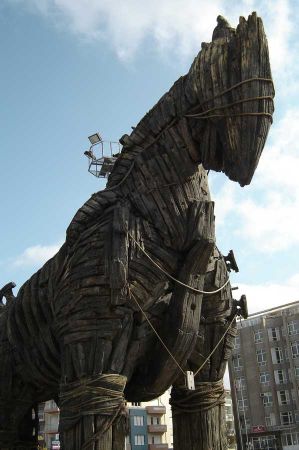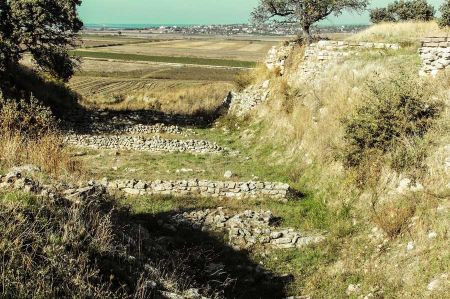Troy - Heinrich Schliemann - Archeologist & Discoverer
- Written by Portal Editor
Troy is probably one of the most well-known ancient cities. This is primarily due to Homer, who processed the history of the city of Troy in his famous epic "Iliad" almost 3,000 years ago.
This work is about the ruler of Troy, who kidnapped the beautiful Greek Helena to Troy.
Helena was the wife of the king of Sparta. In order to get Helena back, the Greeks besieged the city in vain for years until they finally used a kind of trick in building the famous wooden horse. The Trojans pulled this horse into the city because they believed it was a gift of the withdrawn army. When the horse was in town, the Spartans came out of their hiding place inside the horse and were finally able to beat the surprised Trojans.
Background story of Iliad and his Odyssey
 The Greek poet Homer (8th century BC) is considered to be the author of the Iliad and the Odyssey. The Iliad describes the Trojan War at the city of Ilios - Troy itself is the landscape around the city. The question of whether a war between the Greeks and Ilios (Troy) has actually taken place cannot yet be answered conclusively. The question of such a war must be separated from the question of whether the city of Ilios (Troy) existed. Homer is regarded as the founder of western literature, his enormous verses have enjoyed great popularity since ancient times, and even today the question of the real Troy attracts a lot of interest.
The Greek poet Homer (8th century BC) is considered to be the author of the Iliad and the Odyssey. The Iliad describes the Trojan War at the city of Ilios - Troy itself is the landscape around the city. The question of whether a war between the Greeks and Ilios (Troy) has actually taken place cannot yet be answered conclusively. The question of such a war must be separated from the question of whether the city of Ilios (Troy) existed. Homer is regarded as the founder of western literature, his enormous verses have enjoyed great popularity since ancient times, and even today the question of the real Troy attracts a lot of interest.
In ancient Greece there was a real city of Ilion. At that time, it was equated with the famous Troy of Homer. Since the tradition has broken off, the situation of this Troy has also been forgotten.
 Since the 18th century it has been suspected that Troy of Homer is located on Hisarlık hill. The German Heinrich Schliemann dug there on a large scale in the 19th century. Since then, settlements have been found that have arisen over a long period: from the 5th millennium BC. until the 5th century AD.
Since the 18th century it has been suspected that Troy of Homer is located on Hisarlık hill. The German Heinrich Schliemann dug there on a large scale in the 19th century. Since then, settlements have been found that have arisen over a long period: from the 5th millennium BC. until the 5th century AD.
In the middle of today's Turkey there was the Hittite empire, which was founded in the early 12th century BC, collapsed, i.e. around the time in which described the Troy by Homer was located. Hittite sources date from around 1400 to 1200 BC. A city named Wilusa mentioned several times. There are indications that this city may be identical to the Hisarlık complex. In any case, after evaluating a Hittite state treaty found in the 1980s, Wilusa was probably located in the northwest of Anatolia, in Troas area.
 Concerns were also raised against this localization of Wilusa and an equation with Ilion and, even after the evaluation of the state treaty and other sources, Wilusa's localization was represented in completely different places.
Concerns were also raised against this localization of Wilusa and an equation with Ilion and, even after the evaluation of the state treaty and other sources, Wilusa's localization was represented in completely different places.
The German scientist Heinrich Schliemann was so much fascinated by this story that he absolutely wanted to find the location of the event. With his excavations and the discovery of the gold treasure of Troy, he brought ancient history to life and ensured today's interest in the ancient ruins.
Unfortunately, just a few ruins can be visited today. Therefore, Troy cannot keep up with places like Ephesus or Pergamon. Mainly because of the famous stories about Troy, the city is still a visitor magnet.
Troy - The myth about the Trojan horse
 After the Greeks had struggled unsuccessfully for ten years during the Trojan War, the seer Kalchas called a gathering of the most distinguished heroes and advised them not to conquer Troy by force, but with the help of a trick. In other sources, Odysseus or his prisoner Helenos are named as the originators of the trick.
After the Greeks had struggled unsuccessfully for ten years during the Trojan War, the seer Kalchas called a gathering of the most distinguished heroes and advised them not to conquer Troy by force, but with the help of a trick. In other sources, Odysseus or his prisoner Helenos are named as the originators of the trick.
The Greeks then built a large wooden horse, inside of which Greek soldiers could hide. The horse was created from the wood of a dogwood by the Greek hero Epeios, who had appeared in a dream to the goddess Pallas Athena, who had commissioned him to make the mighty steed out of beams by promising her own help to complete the work faster. Late authors continued to embellish the description of the horse, naming the wood known today as Abies equi-trojani ("fir of the Trojan horse") as the tree species for the body. The horse's eyes were made of obsidian and amber, the teeth were made of ivory and the mane was made of real horse hair, the hooves had shone like polished marble. With Athens' help and the support of the atrids, he managed to complete his perfect work of art within three days. The horse bore the inscription "The Greeks this sacrifice of thanks to the goddess Athena for a safe journey home".
 The fighters now got into the horse and the army faked the withdrawal. Sinon, a heroic Greek who volunteered specifically for this purpose, made the Trojans believe that it was a Greek gift to the goddess Athena. The horse will bring them mischief if they destroy it. The Greeks would have built it so big that it wouldn't fit through the city gates. If the Trojans brought it to their city, they would be under the protection of Athena. The priest Laokoon warned the Trojans of the ominous Dana's gift: "Timeo Danaos et dona ferentes" (Latin: I fear the Danes, even if they bring gifts). Kassandra, the daughter of King Priam, also warned vigorously that the horse would bring Troy down.
The fighters now got into the horse and the army faked the withdrawal. Sinon, a heroic Greek who volunteered specifically for this purpose, made the Trojans believe that it was a Greek gift to the goddess Athena. The horse will bring them mischief if they destroy it. The Greeks would have built it so big that it wouldn't fit through the city gates. If the Trojans brought it to their city, they would be under the protection of Athena. The priest Laokoon warned the Trojans of the ominous Dana's gift: "Timeo Danaos et dona ferentes" (Latin: I fear the Danes, even if they bring gifts). Kassandra, the daughter of King Priam, also warned vigorously that the horse would bring Troy down.
 The warnings of Laocoon and Kassandra were ignored in the city. The horse was pulled into the city and placed in front of the Temple of Athena. At night the soldiers crawled out of the horse's belly and opened the city gates. The Greeks who had returned in the night invaded and destroyed the city. This led to numerous acts of wickedness, which should later be difficult for the Greeks on their way home, as the Odyssey or the myths about Ajax report to Lokrer.
The warnings of Laocoon and Kassandra were ignored in the city. The horse was pulled into the city and placed in front of the Temple of Athena. At night the soldiers crawled out of the horse's belly and opened the city gates. The Greeks who had returned in the night invaded and destroyed the city. This led to numerous acts of wickedness, which should later be difficult for the Greeks on their way home, as the Odyssey or the myths about Ajax report to Lokrer.
Please also read:
Elbasan - After Romans and Byzantines - the Ottomans
Bike Tour Lednice - with AZUB Trike and BTurtle
